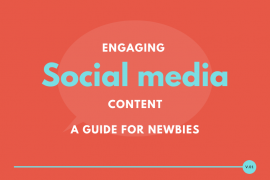Updated January 20th, 2023
Table of Contents
8 Key Elements for a Successful Website
The success of your website plays a key role in the overall success of your business or organization. It serves as a tool to attract new customers, build relationships with existing ones, showcase your brand and products, provide customer support and increase sales.
But how can you ensure that your website looks great and functions perfectly? The answer lies in understanding the key elements necessary for building a successful website. Here are the top 8 key elements of a successful website.
1. Social Media Integration
Social media is integral to any digital marketing strategy and should be integrated into your website.
Integrating social media into your website allows customers to easily share information about your brand, products, or services with their friends and family, creating more exposure for your business.
You can add icons for popular social networks like Facebook, Twitter, and Instagram to your website and link to each one’s profile page. You can also add comment boxes or feeds from your social media accounts to allow customers to interact with you directly on the site.
By integrating your website with social media platforms, you can increase your brand’s visibility, engage with customers and prospects, build relationships and even drive sales.
You can create shareable content on social media to draw in new visitors to your website and increase traffic. You can also use social media to monitor customer feedback, respond to queries quickly, track conversions, and measure success.
2. Mobile Friendly Design
With more and more people using mobile devices to access the web, it is essential to ensure that your website is mobile-friendly. A responsive design ensures that your website looks great on all devices and browsers, from desktop PCs to tablets and smartphones.
It also helps you rank higher in search engine results, as Google now prioritizes websites with a mobile-friendly design. A mobile-friendly website should have a clean and simple layout, with buttons and text boxes clearly labeled and easily clickable.
The navigation should be intuitive, and the content easy to read on any device. Additionally, ensure your images are optimized for mobile devices to avoid loading delays.
If you have videos or animations, make sure they are optimized for desktop and mobile to ensure a smooth, uninterrupted experience.
Remember that a website is only as effective as it is accessible. That’s why testing your website on multiple devices before launch is essential. It will help you identify potential issues early on and ensure a flawless user experience on all devices.
3. Branding
Branding is an essential part of any successful website. A good brand will help you stand out from the competition and attract more customers. It should be thoughtfully created to reflect your company’s values, mission, vision, and products or services.
Consider the customer experience that your website’s branding and overall design provide.
To build a successful brand, start with an effective logo design, as this will be a key identifier of your business. It should be recognizable and memorable, so customers associate it with your company.
Additionally, you can use fonts, colors, and images that reflect your brand; these should all be used consistently across the website to create a cohesive look.
Working with a reputable digital marketing agency, such as gravitate digital, can help you develop a strong brand.
A successful partnership with a digital marketing agency will provide lasting results across all business areas, including increased website traffic, effective lead conversion, and heightened visibility of products or services.
4. SEO Optimization
Search Engine Optimization (SEO) is one of the most important factors to consider when creating and maintaining a website. It helps ensure that your website is visible in search engine results, attracting more visitors and potential customers.
While there are many elements to consider when optimizing your website for SEO, you can take some simple steps to ensure it is appropriately optimized.
The first step in SEO optimization is researching the right keywords for your website. Selecting the right keywords will help get your site found in search engine results and attract more visitors to your page.
You should think like a customer and determine what keywords they would use when searching for products or services related to what you offer.
Once you have identified the best keywords, you can add them to your title tags, meta descriptions, headings, and image alt-texts, to increase the chances of ranking in the search engine results pages (SERPs) for those keywords.
Doing a regular SEO audit is also important because it can help you identify any areas that you can improve. It will help you understand how search engines view your website and provide insights for better rankings.
This includes technical audits, content optimization, keyword research, and link analysis.
5. High-Quality Visuals
People are visual creatures, so it’s crucial to have high-quality visuals on your website. It could include anything from product photos and logos to videos, graphics, and animations.
Quality visuals can make your website look more professional, attractive, and memorable. It can also help you stand out from the competition by giving your website a unique look and feel.
When choosing visuals for your website, make sure to use high-resolution images that are optimized for web viewing and loading. It will ensure clear, crisp visuals across all devices and browsers.
Additionally, avoid using too many visuals as it can slow down the loading time of your website and affect user experience. Ensure the visuals are relevant to your content and support your brand identity.
Good visuals can create an emotional connection with customers, encourage engagement, and drive conversions. They can also help break up long chunks of text so that users can stay energized and energized.
By adding high-quality visuals to your website, you can create an exciting and memorable user experience that will keep customers coming back.
6. User-Friendly Navigation
Having a user-friendly navigation structure is essential for any successful website. This refers to how visitors can move from one page to another and should be well-structured and intuitive.
Poor navigation can lead to frustrated users who will quickly leave your website and never return. The navigation structure should be easy to understand and allow users to access the information they need.
The menus should be clearly labeled, and it’s helpful to include a search bar if your website is large or complex. Drop-down menus help organize topics into categories, making them easier to find.
Additionally, use breadcrumb links to help users track where they are on the website. A user-friendly navigation structure makes it easy for visitors to find the information they want.
It will also reduce bounce rate and increase user engagement, as people will be more likely to continue browsing your website if they can easily find what they need.
Additionally, ensure clear and consistent navigation across all pages so users can easily understand. By creating a well-structured navigation system, you can ensure an enjoyable user experience on your website.
7. Clear Call to Action
A clear call to action (CTA) is essential for any website. It’s the main way you can drive conversions, as it encourages users to take action, such as signing up for your newsletter or making a purchase.
Your CTA should be simple, so there’s no confusion about what you want people to do. Additionally, include a CTA on every page of your website, as this will increase visibility and encourage more users to take action.
Before creating a CTA, start by identifying what action you want people to take. This could be anything from signing up for your newsletter or downloading an app to making a purchase or subscribing to your service.
Once you know what action you want people to take, create a CTA button or link that will direct them to the correct page. Make sure to choose an eye-catching color, so it stands out from the rest of the content on your website.
Use robust and persuasive language in your CTA to encourage visitors to take action. A clear CTA can make it easy for users to find what they are looking for and take the desired action.
It can help boost your conversions as more people will be encouraged to take advantage of your offers.
Additionally, use tools like Google Analytics to track how many people are clicking on your CTA and if they are taking the desired action to refine your CTA in the future, so it is more effective.
8. Security
Security is key when creating a website and should not be taken lightly. Sites are vulnerable to threats such as hackers, malware, and data breaches, which can seriously affect customers and businesses.
That is why ensuring that your website’s data is protected from malicious attacks is essential. This includes encryption of confidential information, such as passwords and credit card numbers, so unauthorized users cannot access it.
Additionally, you should use secure servers that are regularly monitored and updated to keep them safe from any threats. You should also add a privacy policy to your website, so visitors know how their data is being used, stored, and shared.
It will help protect you from any legal issues that may arise in the future. Additionally, if you are collecting customer information for marketing purposes, ensure it is done in a GDPR-compliant manner.
If you use third-party services such as payment gateways or analytics tools, ensure they have been vetted for security before integrating them into your website. It will help ensure that your customer’s data is always secure.
Make sure to update your website regularly to address any security vulnerabilities promptly. Creating a successful website is essential for any business. With the right strategy and tools, you can ensure that your website stands out from the rest and attracts more visitors.
Use SEO strategies to optimize your pages and make them visible in search engine results.
Additionally, prioritize security by encrypting confidential information, using secure servers, adding a privacy policy, and regularly updating your website. With the right approach, you can ensure that your website is optimized for success.












